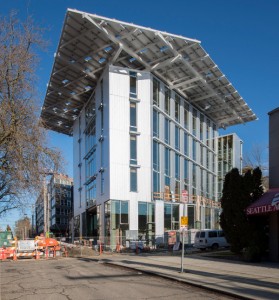HatiCon Solar repurposed a ground-mount to fit on the roof of a new green building in Seattle.
At its grand opening on Earth Day (April 22) this year, the Bullitt Center introduced itself to Seattle and the world. The six-story, 50,000-sq-ft office building is the first urban commercial building in the United States to meet the goals of the Living Building Challenge. The international certificate program, created in 2006, promotes the most advanced measurement of sustainability in building. Influenced in seven performance areas — beauty, energy, equity, health, materials, site and water — projects that achieve the Living Building Challenge are the greenest in the world.

The Bullitt Center, here still being finished, has a 242-kW solar system on its roof, manufactured by HatiCon Solar. Photos courtesy of John Stamets.
In the case of the Bullitt Center, in addition to its wooden frame (which should extend the structure’s lifespan to 250 years), automatically programed windows (for temperature regulation), oversized windows and high ceilings (to provide 82 percent of the center’s lighting naturally) and composting toilets (all water and waste is treated on site), the $30 million building is completely off-grid, using geothermal energy and a 242-kW solar power system.
The large rooftop system is unique in that it’s actually a ground-mount refurbished to fit on top of the building. HatiCon Solar, an Ontario, Calif.-based mounting and racking manufacturer, produces systems for pitched roofs, flat roofs and ground, but found its all-aluminum, ground-mount the most ideal for the Bullitt Center. Additional testing and certification was needed — the city had to approve the solar panels to extend out over the sidewalk — but HatiCon Solar’s involvement in the ground-breaking project was fairly uncomplicated.
HatiCon Solar founded in 2009 and has more than 100 MW of product in the ground in the United States thus far. Each system uses pre-assembled components and few parts to provide a quick installation, including universal module clamps that slide and click onto structural rails. HatiCon Solar systems are all-aluminum (except for stainless steel hardware and ground posts), which provides an even greener product for customers.
“At the end of the project’s life, [the mounting/racking system] is 98 percent recyclable,” says Eduardo Lainez, sales and marketing coordinator. “If you’re doing a large ground-mount installation and you’re looking at an ROI of a few years, at the end of life of the whole project, instead of getting 10 cents on the dollar for a steel-structure system, you’re getting closer to 70 to 90 cents on the dollar for an aluminum system. You’re actually generating some money on the backend, which is nice.”
HatiCon Solar’s mounting systems are very flexible, and Lainez says the company has found itself doing a lot of odd projects — the Bullitt Center being maybe the oddest. The HatiCon Solar ground-mount product was reconfigured to be placed on the roof of the six-story building.
![]()
HatiCon Solar installed a ground-mount system on the roof of the six-story Bullitt Center in Seattle.
Photos courtesy of John Stamets.
“The roof in particular could take a really strong point load, so you could do large spans,” Lainez says of the Bullitt project. “It’s more like BIPV than a stand-alone system on top. They needed a specific flush look. They were looking for an aesthetic look, so we modified our system.”
Assembly of the system was done on the roof, as it was easier to move the parts piece by piece. HatiCon modified and tested its existing ground-mount system with new aluminum connections to meet all requirements and building codes.
“We did do additional tests, both for installation and rain to make sure the rain would run off correctly, that the installation would work,” Lainez says. “The rails are extremely light and extremely strong, and the point load on the roof isn’t extremely heavy. There’s that wind strength, and it can take the snow load.”
The 242-kW system should produce more than enough energy for the Bullitt Center year-round. With super-insulated walls, a highly efficient heating and cooling system and the large windows, less electricity is needed to heat and cool the building and keep it lit up. Large electricity suckers, like computers, servers and other office equipment, are put on an energy limit. Tenants of the building can swap unused portions of their energy budget to other tenants, thus sharing the center’s full range of benefits.
Solar power makes up a small portion of the Bullitt Center, but it’s making a huge presence in producing a net-zero building, thanks to HatiCon Solar’s innovative mounting solution.
— Solar Builder magazine
[source: http://www.solarbuildermag.com/featured/haticon-solar-bullitt-center/]

Leave a Reply
You must be logged in to post a comment.